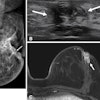Tomosynthesis is one of the most promising new mammography technologies, applying 3D imaging techniques to what has historically been a 2D modality. A British start-up firm is so taken with the potential of tomosynthesis that it has based its business plan on the technology.
Breast tomosynthesis systems involve the use of a digital mammography gantry that is adapted to enable it to tilt around the breast, taking images at multiple angles rather than in a single projection. Tomosynthesis data can then be reconstructed into image volumes that give radiologists additional flexibility in viewing data. Tomosynthesis-based mammography units are under development by several vendors, but none has yet been released as a commercial product.
Dexela of London believes that tomosynthesis overcomes the principal drawbacks to conventional mammography, including false positives, patient discomfort, and cancers hidden by overlapping tissue. To that end, the firm is developing a dedicated tomosynthesis workstation based on proprietary algorithms that create 3D reconstructions from 2D x-ray mammography images.
Dexela CEO Edward Bullard believes that digital breast tomosynthesis can provide superior 3D images at the same or lower radiation dose as conventional 2D mammography, with no reduction in caseload capability.
"We believe tomosynthesis will be the way to do breast cancer screening," Bullard said. "We think it will be cost-effective and will significantly reduce callback rates, which are expensive."
Dexela's DexTop workstation will take data from a tomosynthesis mammography system and process it using the company's algorithms, completing a reconstruction in less than three minutes on a standard PC. The company also hopes the workstation can form the platform for multimodality image registration and computer-aided detection (CAD).
Dexela is talking with several major breast imaging equipment manufacturers, but at the moment its only public relationship is with Swedish company XCounter, which is developing 3D digital detector technology for mammography.
Dexela will begin clinical testing of a prototype workstation within the next three months, Bullard said. The company will show a work-in-progress DexTop system at the booth of display developer Planar Systems of Waltham, MA, at this year's RSNA conference in Chicago, Bullard said.
Dexela was formed in 2005 and is privately held. Its financial backing includes venture capital firm Close Venture Management, which invested $2.3 million into the company earlier this year. Dexela also was awarded an R&D grant by the London Development Agency's Innovation Unit. Previously known as the SMART Award, the R&D grant helps small and medium-sized businesses research and develop technologically innovative products and processes.
Bullard has the dual role of managing director and CEO, while Dr. Marty Stanton serves as president and head of R&D. Before co-founding Dexela, Bullard founded and directed a London-based software and IT company, while Stanton had led a research group at Brandeis University in Waltham, MA, that originally developed the 3D breast imaging methods now being commercialized by Dexela.
Among those strongly supporting the potential of tomosynthesis is Dr. Daniel Kopans, professor of radiology at Harvard University in Cambridge, MA, and founder of the breast imaging division at Massachusetts General Hospital of Boston. He believes tomosynthesis eliminates the "guesstimates" that come with 2D imaging when early signs of cancer can be hidden by overlapping normal breast tissue.
"We like what Dexela is doing. We say they're developing a workstation designed by radiologists for radiologists," Kopans said. According to Kopans, the workstation brings up images with no downtime despite the large amount of data required for tomosynthesis images, typically 30 to 80 images for a 6-cm-thick breast.
Some tomosynthesis advocates believe the technology could supplant 2D mammography even for widescale screening. Although it will improve imaging of younger women with dense breasts, tomosynthesis will probably not be the penultimate solution for these patients. Kopans said his team also has not studied the use of tomosynthesis in women with breast implants.
Tomosynthesis may also result in some changes in image acquisition. Technologists may not have to compress the breasts as much as needed for 2D mammography, but will have to pay closer attention to patient motion. Image acquisition times for tomosynthesis should be about 10 to 15 seconds, and department workflow should remain about the same, Bullard said.
By Brenda Tilke
AuntMinnie.com contributing writer
October 27, 2006
Related Reading
Dexela scores funding, May 19, 2006
Swedish start-up XCounter pursues 3D mammography, March 20, 2006
Copyright © 2006 AuntMinnie.com


















